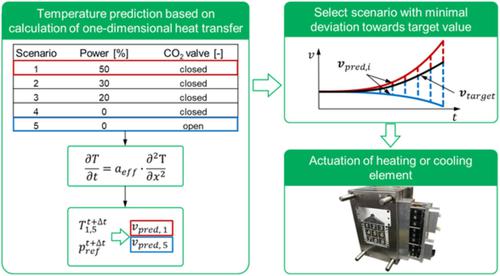当前位置:
X-MOL 学术
›
Polym. Eng. Sci.
›
论文详情
Our official English website, www.x-mol.net, welcomes your feedback! (Note: you will need to create a separate account there.)
Development of a novel control strategy for a highly segmented injection mold tempering for inline part warpage control
Polymer Engineering and Science ( IF 3.2 ) Pub Date : 2020-08-07 , DOI: 10.1002/pen.25481 Christian Hopmann 1 , Cemi Kahve 1 , Mauritius Schmitz 1
Polymer Engineering and Science ( IF 3.2 ) Pub Date : 2020-08-07 , DOI: 10.1002/pen.25481 Christian Hopmann 1 , Cemi Kahve 1 , Mauritius Schmitz 1
Affiliation

|
The demand of precise injection‐molded parts is steadily increasing and is today one of the most relevant challenges, due to local variations in temperature and pressure during the production of the part. These variations can lead to a significant change of the local specific volume, shrinkage potential, and inner stress, which ultimately results in part warpage. By homogenizing the local specific volume over the part according to the specific pvT‐behavior of the polymer, warpage is expected to be reduced. The following work describes a new approach to control the local specific volume by a newly developed segmented and highly dynamic mold temperature control based on rapid heating ceramics and CO2 evaporation chambers. Since injection molding is a dynamic process and heat transfer inside the mold is comparably slow, a special control strategy is necessary to activate the heating and cooling elements in advance. For this, a novel prediction strategy based on a discretization of the one‐dimensional heat equation has been developed. Experimental trials including a classical PID controller and a model predictive control approach (MPC) show that the MPC is superior regarding the process stability.
中文翻译:

开发一种新的控制策略,用于高度分段的注塑模具回火,以实现在线零件翘曲控制
由于零件生产过程中温度和压力的局部变化,对精密注塑零件的需求正在稳步增长,如今已成为最相关的挑战之一。这些变化可能导致局部比容,收缩潜力和内部应力发生重大变化,最终导致零件翘曲。通过根据聚合物的特定pvT行为均匀化零件上的局部比容,可望减少翘曲。以下工作描述了一种新方法,该方法通过基于快速加热的陶瓷和CO 2的最新开发的分段和高动态模具温度控制来控制局部比容蒸发室。由于注射成型是一个动态过程,并且模具内部的传热相对较慢,因此需要一种特殊的控制策略来预先激活加热和冷却元件。为此,已经开发了一种基于一维热方程离散化的新颖预测策略。包括经典PID控制器和模型预测控制方法(MPC)在内的实验试验表明,MPC在过程稳定性方面具有优越性。
更新日期:2020-08-07
中文翻译:

开发一种新的控制策略,用于高度分段的注塑模具回火,以实现在线零件翘曲控制
由于零件生产过程中温度和压力的局部变化,对精密注塑零件的需求正在稳步增长,如今已成为最相关的挑战之一。这些变化可能导致局部比容,收缩潜力和内部应力发生重大变化,最终导致零件翘曲。通过根据聚合物的特定pvT行为均匀化零件上的局部比容,可望减少翘曲。以下工作描述了一种新方法,该方法通过基于快速加热的陶瓷和CO 2的最新开发的分段和高动态模具温度控制来控制局部比容蒸发室。由于注射成型是一个动态过程,并且模具内部的传热相对较慢,因此需要一种特殊的控制策略来预先激活加热和冷却元件。为此,已经开发了一种基于一维热方程离散化的新颖预测策略。包括经典PID控制器和模型预测控制方法(MPC)在内的实验试验表明,MPC在过程稳定性方面具有优越性。



























 京公网安备 11010802027423号
京公网安备 11010802027423号